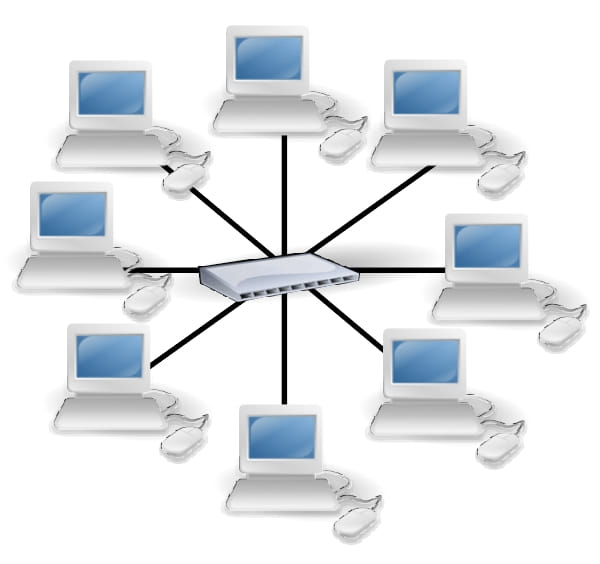✅ Last checked on
In the realm of networking, the design and architecture you choose can significantly impact the efficiency and reliability of your connections. One such design is the Star Topology, a centralized network arrangement that offers both advantages and challenges.
In this article, we’ll delve deep into the Star Topology: Understanding the Centralized Network Design, examining its core principles, benefits, implementation, and more.
Star Topology: Understanding the Centralized Network Design

Star Topology, often referred to as a “hub and spoke” configuration, is a network setup where all devices are connected directly to a central hub. Imagine the central hub as the sun, and the devices as its surrounding planets – each planet communicates with the sun, but not with each other. This hub-centric approach simplifies the network structure and enhances manageability.
Advantages of Star Topology
Enhanced Reliability
In a Star Topology, if one device encounters a technical glitch or fails, it doesn’t disrupt the entire network. Other devices can continue to function seamlessly, reducing downtime and improving overall reliability.
Easy Troubleshooting
Isolating issues becomes straightforward in this design. Since each device is connected individually to the central hub, identifying and rectifying problems is much quicker, compared to complex interconnected setups.
Scalability at Ease
Adding new devices to the network is a breeze. You simply connect the new device to the central hub. This scalability makes Star Topology ideal for businesses anticipating growth or changes in their network.
Centralized Management
With all devices converging at a central hub, network administrators can efficiently manage, monitor, and control the entire network from a single location, streamlining maintenance tasks.
Reduced Network Traffic
Unlike mesh or bus topologies where data collision is common, Star Topology ensures minimal data collision due to direct connections between devices and the hub, leading to optimized data transfer.
Drawbacks of Star Topology
Dependency on Central Hub
The central hub is the heart of this network. If it fails, the entire network can go down. Redundancy measures are crucial to prevent such single points of failure.
Cost of Implementation
Setting up a Star Topology demands more cabling compared to some other designs, potentially leading to higher initial installation costs.
Limited Length of Connections
The physical distance between the central hub and devices is limited by the type of cabling used. Longer distances might require additional hardware like repeaters.
Scalability Constraints
While Star Topology is generally scalable, there’s a practical limit to how many devices can be effectively connected to a single hub. Large-scale networks might require complex configurations.
Real-world Applications
Home Networks
Many home networks employ Star Topology. A router serves as the central hub, connecting various devices like computers, smartphones, and smart TVs.
Small Businesses
Small businesses benefit from the simplicity and easy management of Star Topology. It suits setups where a central server or data center connects to individual workstations.
Educational Institutions
Schools and colleges often use Star Topology for their computer labs. This design simplifies network maintenance, ensuring minimal disruptions in an educational environment.
Call Centers
Call centers rely on uninterrupted communication. Star Topology aids in quick issue identification, reducing downtime and ensuring seamless customer interactions.
Implementing Star Topology: Step-by-step
- Plan Your Network Layout: Determine the location of the central hub and the devices you need to connect. Consider factors like proximity and cable length.
- Select Cabling: Choose suitable cabling – Ethernet cables are common for Star Topology due to their reliability and availability.
- Set up the Central Hub: Install the central hub, which can be a router or a switch, at the chosen location. Connect it to power and the main data source.
- Connect Devices: Attach each device to the central hub using individual cables. Ensure proper labeling for easy troubleshooting.
- Test and Configure: Power up the network and test connections. Configure the central hub’s settings and security protocols.
- Implement Redundancy: To prevent single points of failure, consider redundancy options like secondary hubs or backup power supplies.
FAQs
Is Star Topology suitable for large organizations?
While Star Topology is effective for small to medium-sized setups, large organizations might face scalability challenges.
What’s the main advantage of Star Topology?
Enhanced reliability due to isolated device connections is one of the primary advantages.
Can I mix different network topologies?
Yes, hybrid topologies that combine different designs are possible, catering to specific organizational needs.
What happens if the central hub malfunctions?
If the central hub fails, the entire network can be disrupted. Redundancy measures should be in place to avoid this.
Does Star Topology eliminate data collisions entirely?
While it significantly reduces data collisions, they can still occur in certain scenarios.
What’s the difference between Star and Mesh topologies?
In Star Topology, all devices connect to a central hub, while in Mesh Topology, devices interconnect with each other.
Conclusion
Understanding the Star Topology’s centralized network design is essential for anyone involved in network setup and maintenance. Its reliability, easy troubleshooting, and scalability make it a compelling choice for various applications. While it’s not without its drawbacks, strategic implementation and redundancy planning can mitigate most challenges. By grasping the nuances of Star Topology, you can ensure robust and efficient network connectivity.